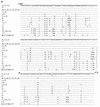Molecular epidemiology of two consecutive outbreaks of parainfluenza 3 in a bone marrow transplant unit
- PMID: 9666007
- PMCID: PMC105033
- DOI: 10.1128/JCM.36.8.2289-2293.1998
Molecular epidemiology of two consecutive outbreaks of parainfluenza 3 in a bone marrow transplant unit
Abstract
Two consecutive nosocomial outbreaks of parainfluenza 3, in which 5 of 15 infected patients died, occurred in an adult bone marrow transplant unit. Parainfluenza 3 strain variation was assessed by reverse transcription-PCR sequencing of part of the parainfluenza 3 F gene, including the noncoding region, directly from clinical samples. Sequence data from the outbreaks were compared with those from 15 other parainfluenza 3 isolates circulating concurrently in the community; altogether, 13 strains which fell into three lineages were identified. Four immunosuppressed patients shed virus persistently for between 1 and 4 months without change in sequence. The first outbreak lasted 4 months and involved three parainfluenza 3 strains, and one persistently infected patient was implicated as the source of infection for three others. The second outbreak lasted for 1 month but involved only one strain. These data indicate that introduction of community parainfluenza 3 strains to the bone marrow transplant unit was followed by person-to-person transmission within the unit rather than reintroduction of virus from the community.
Figures



Similar articles
-
Molecular investigations of an outbreak of parainfluenza virus type 3 and respiratory syncytial virus infections in a hematology unit.J Clin Microbiol. 2007 Jun;45(6):1690-6. doi: 10.1128/JCM.01912-06. Epub 2007 Mar 28. J Clin Microbiol. 2007. PMID: 17392447 Free PMC article.
-
Molecular epidemiology and environmental contamination during an outbreak of parainfluenza virus 3 in a haematology ward.J Hosp Infect. 2017 Dec;97(4):403-413. doi: 10.1016/j.jhin.2017.09.003. Epub 2017 Sep 8. J Hosp Infect. 2017. PMID: 28893615 Free PMC article.
-
Nosocomial transmission of parainfluenza 3 virus in hematological patients characterized by molecular epidemiology.Transpl Infect Dis. 2011 Aug;13(4):433-7. doi: 10.1111/j.1399-3062.2011.00603.x. Epub 2011 Apr 5. Transpl Infect Dis. 2011. PMID: 21466639
-
Molecular epidemiology of an outbreak of human parainfluenza virus 3 among oncology patients.J Hosp Infect. 2019 Nov;103(3):349-353. doi: 10.1016/j.jhin.2019.07.012. Epub 2019 Jul 26. J Hosp Infect. 2019. PMID: 31356855
-
[Diagnostic tests: Parainfluenza virus 1, 2, 3, 4].Nihon Rinsho. 2005 Jul;63 Suppl 7:349-51. Nihon Rinsho. 2005. PMID: 16111271 Review. Japanese. No abstract available.
Cited by
-
Parainfluenza virus type 3 pneumonia in bone marrow transplant recipients: multiple small nodules in high- resolution lung computed tomography scans provide a radiological clue to diagnosis.Clin Infect Dis. 2009 Apr 1;48(7):905-9. doi: 10.1086/597297. Clin Infect Dis. 2009. PMID: 19222373 Free PMC article.
-
Evaluation of a clinical scoring system and directed laboratory testing for respiratory virus infection in hematopoietic stem cell transplant recipients.Transpl Infect Dis. 2011 Oct;13(5):448-55. doi: 10.1111/j.1399-3062.2011.00631.x. Epub 2011 Apr 18. Transpl Infect Dis. 2011. PMID: 21501357 Free PMC article.
-
Human rhinovirus C in adult haematopoietic stem cell transplant recipients with respiratory illness.J Clin Virol. 2013 Mar;56(3):255-9. doi: 10.1016/j.jcv.2012.11.010. Epub 2013 Jan 3. J Clin Virol. 2013. PMID: 23290385 Free PMC article.
-
Epidemiology of parainfluenza infection in England and Wales, 1998-2013: any evidence of change?Epidemiol Infect. 2017 Apr;145(6):1210-1220. doi: 10.1017/S095026881600323X. Epub 2017 Jan 18. Epidemiol Infect. 2017. PMID: 28095926 Free PMC article.
-
The challenge of respiratory virus infections in hematopoietic cell transplant recipients.Br J Haematol. 2008 Nov;143(4):455-67. doi: 10.1111/j.1365-2141.2008.07295.x. Epub 2008 Sep 10. Br J Haematol. 2008. PMID: 18785968 Free PMC article. Review.
References
-
- Brady M T, Evans J, Cuartas J. Survival and disinfection of parainfluenza viruses on environmental surfaces. Am J Infect Control. 1990;18:18–23. - PubMed
-
- Cane P A, Mathews D A, Pringle C R. Analysis of relatedness of subgroup A respiratory syncytial viruses isolated worldwide. Virus Res. 1992;25:15–22. - PubMed
-
- Chanock R M, Bell J A, Parrott R H. Natural history of parainfluenza infection. Perspect Virol. 1961;2:126–138.
Publication types
MeSH terms
Substances
LinkOut - more resources
Full Text Sources
Medical

